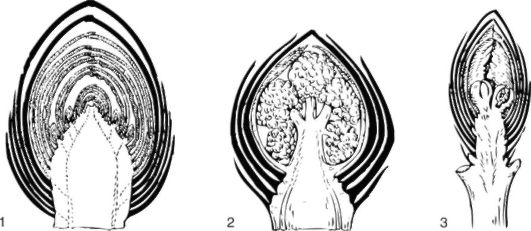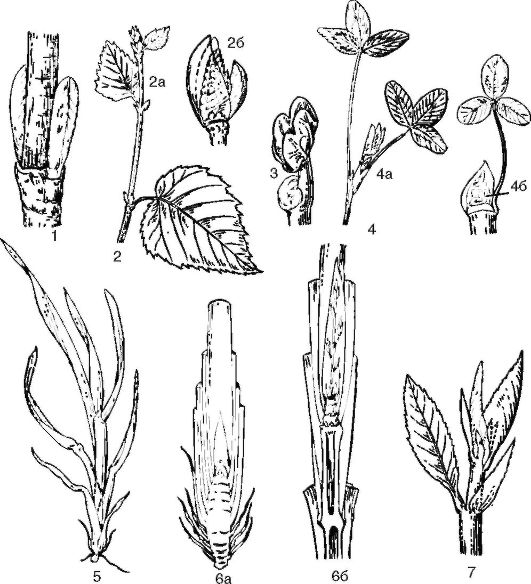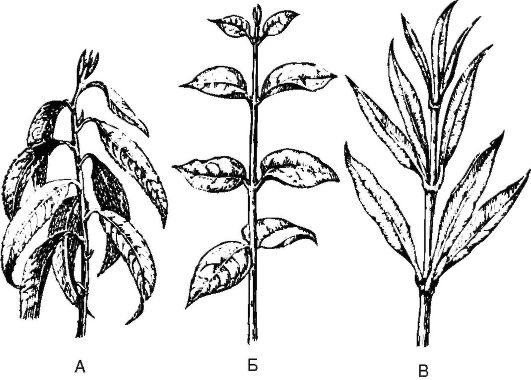General characteristics of shoots and buds
General characteristics of shoots and buds
The shoot consists of the axis of the stem and the leaves and buds extending from it. In a more specific sense, a shoot can be called an annual unbranched stem with leaves and buds that has developed from a bud or seed. The shoot develops from the bud of the embryo or axillary bud and is one of the main organs of higher plants. Thus, the bud is a rudimentary shoot. The function of the shoot is to air the plant. A modified shoot - in the form of a flower or a spore-bearing shoot - performs the function of reproduction.
The main organs of the shoot are the stem and leaves, which are formed from the meristem of the growth cone and have a single conducting system (Fig. 3.11). The section of the stem from which the leaf (or leaves) departs is called knot, and the distance between the nodes is internode. Depending on the length of the internode, each repeated knot with an internode is called metamer. As a rule, there are many metameres along the shoot axis; the escape consists of a series of metameres. Depending on the length of internodes, shoots are elongated (in most woody plants) and shortened (for example, fruits in an apple tree). In such herbaceous plants as dandelion, strawberry, plantain, tamed shoots are presented in the form of a root rosette.
Stem is called a plant organ, which is the axis of the shoot and bears leaves, buds and flowers.
The main functions of the stem. The stem performs supporting, conducting and storage functions; in addition, it is an organ of vegetative reproduction. Through the stem, the connection between roots and leaves is carried out. In some plants, only the stem performs the function of photosynthesis (horsetail, cactus). The main external feature that distinguishes the shoot from the root is the presence of leaves.
Sheet is a flat lateral organ extending from the stem and having limited growth. The main functions of the leaf: photosynthesis, gas exchange, transpiration. The leaf sinus is the angle between the leaf and the overlying portion of the stem.
Bud- This is a rudimentary, not yet developed shoot. Various signs are put into the classification of the kidneys: on vegetative-generative (6b); 7 - bird cherry; growing shoot tip the composition and functions kidneys are vegetative, vegetative-generative and generative.
Vegetative the bud consists of the cone of growth of the stem, the buds of the leaves, the buds of the buds and the kidney scales.
V vegetative-generative a number of metameres are laid in the buds, and the growth cone is transformed into a rudimentary flower or inflorescence.
Generative, or floral, buds contain only the rudiment of an inflorescence (cherry) or a single flower.
Rice. 3.11. The main parts of the shoot: A - shortened shoot of the eastern plane tree: 1 - internode; 2 - annual increments; B - elongated shoot

Rice. 3.12. Various types of closed buds: 1 - vegetative bud (oak); 2 - vegetative-generative bud (elderberry); 3 - generative bud (cherry)
By the presence of protective scales kidneys are closed (Fig. 3.12) and open (Fig. 3.13). Closed the buds have covering scales that protect them from desiccation and temperature fluctuations (in most plants in our latitudes). Closed kidneys can fall into a dormant state for the winter, which is why they are also called wintering. Open kidneys - naked, without protective scales. In them, the growing cone is protected by the rudiments of the middle leaves (in buckthorn, brittle; tree species of the tropics and subtropics; aquatic flowering plants). The buds from which the shoots grow in spring are called buds. renewal.
By location on the stem kidneys are apical and lateral. Due to the apical bud, the growth of the main shoot is carried out; due to lateral buds - its branching. If the apical bud dies, the lateral bud starts to grow. The generative apical bud, after the unfolding of the apical flower or inflorescence, is no longer capable of apical growth.

Rice. 3.13. The structure of open buds: 1 - wintering buds of viburnum-gordovina; 2 - birch; the tip of the growing shoot (2a) and its apical bud (2b); 3 - bud of nasturtium; 4 - clover bud; general view (4a) and a diagram of the internal structure (4b); 5 - the shoot of the cereal; 6 is a diagram of a longitudinal section of its apical kidney; vegetative (6a) and
Axillary kidneys are laid in the leaf axils and give lateral shoots of the following order. The axillary buds have the same structure as the apical ones. The growth cone is represented by the primary meristem, protected by rudimentary leaves, in the sinuses of which there are axillary buds. Many axillary buds are dormant, which is why they are also called sleeping(or with eyes). Accessory buds usually develop on the roots. In woody and shrub plants, root shoots arise from them.
Deployment of the shoot from the bud. The first shoot of a plant is formed when a seed germinates from an embryonic shoot. This is the main escape, or 1st order escape. All subsequent metameres of the main shoot are formed from the embryonic bud. From the lateral axillary buds of the main shoot, lateral shoots of the 2nd, and later - of the 3rd order are formed. This is how a system of shoots is formed (main and lateral shoots of the 2nd and subsequent orders).
The bud-to-shoot transformation begins with the opening of the bud, the emergence of leaves and the growth of internodes. The kidney scales dry up quickly and fall off when the kidney begins to unfold. They often leave scars at the base of the shoot - the so-called kidney ring, which is clearly visible in many trees and shrubs. By the number of kidney rings, the age of the branch can be calculated. Shoots growing from buds in one growing season are called annual shoots, or annual growth.
V growth of the shoot in length and thickness a number of meristems are involved. The growth in length occurs due to the apical and intercalary meristems, and in thickness due to the lateral meristems (cambium and phellogen). At the initial stages of development, the primary anatomical structure of the stem is formed, which in monocotyledonous plants persists throughout their life. In dicotyledonous and gymnosperms, as a result of the activity of secondary educational tissues, the secondary structure of the stem is formed rather quickly from the primary structure.
Leaf arrangement- the order of placement of leaves on the axis of the shoot (Fig. 3.14). There are several options for leaf arrangement:
1) alternate, or spiral - one leaf departs from each node of the stem (birch, oak, apple, peas);

Rice. 3.14. Leaf arrangement: A - regular (common peach); B - opposite (oval-leaved privet); B - whorled (oleander)
2) opposite - on each node two leaves (maple) are attached against each other;
3) oppositely - a kind of opposite, when opposite leaves of one node are in the mutually perpendicular plane of another node (luciferous, clove);
4) whorled - 3 or more leaves extend from each node (raven eye, anemone).

Rice. 3.15. Types of branching shoots: apical dichotomous: A - diagram; B - algae (dictyote); lateral monopodial: B - scheme; G - pine branch; lateral sympodial monohasia type: D - scheme; E - a branch of bird cherry; lateral sympodial dichasia type: F - scheme; Z - a branch of lilac; 1-4 - axes of the first and subsequent orders
Branch nature of the shoot(fig. 3.15). Shoot branching in plants is necessary to increase the area of contact with the environment - water, air, soil. Distinguish between monopodial, sympodial, pseudo-dichotomous and dichotomous branching of the shoot.
1. Monopodial- shoot growth is maintained for a long time due to the apical meristem (in spruce).
2. Sympodial- annually, the apical bud dies off, and shoot growth continues due to the nearest lateral bud (near a birch).
3. Pseudo-dichotomous(with an opposite leaf arrangement, a variant of sympodial) - the apical bud dies off, and growth is due to the 2 nearest lateral buds located below the apex (in maple).
4. Dichotomous- the cone of growth of the apical kidney (apex) is divided in two (plow, marching, etc.).
By the nature of the location of the shoot in space, they are distinguished:erect the escape; ascending an shoot that develops horizontally in the hypocotyl part, and then grows upward as an erect one; creeping shoot - grows horizontally, parallel to the surface of the earth. If the creeping stem has axillary buds that take root, the shoot is called creeping(or mustache). In creeping shoots, adventitious roots (tradescantia) or stolon whiskers are formed at the nodes, ending in a basal rosette and giving rise to daughter plants (strawberries). Curly the shoot wraps around additional support, since mechanical tissues (bindweed) are poorly developed in it; kissing the stem grows, like a curly one, around an additional support, but with the help of special devices, antennae, a modified part of a complex leaf.







